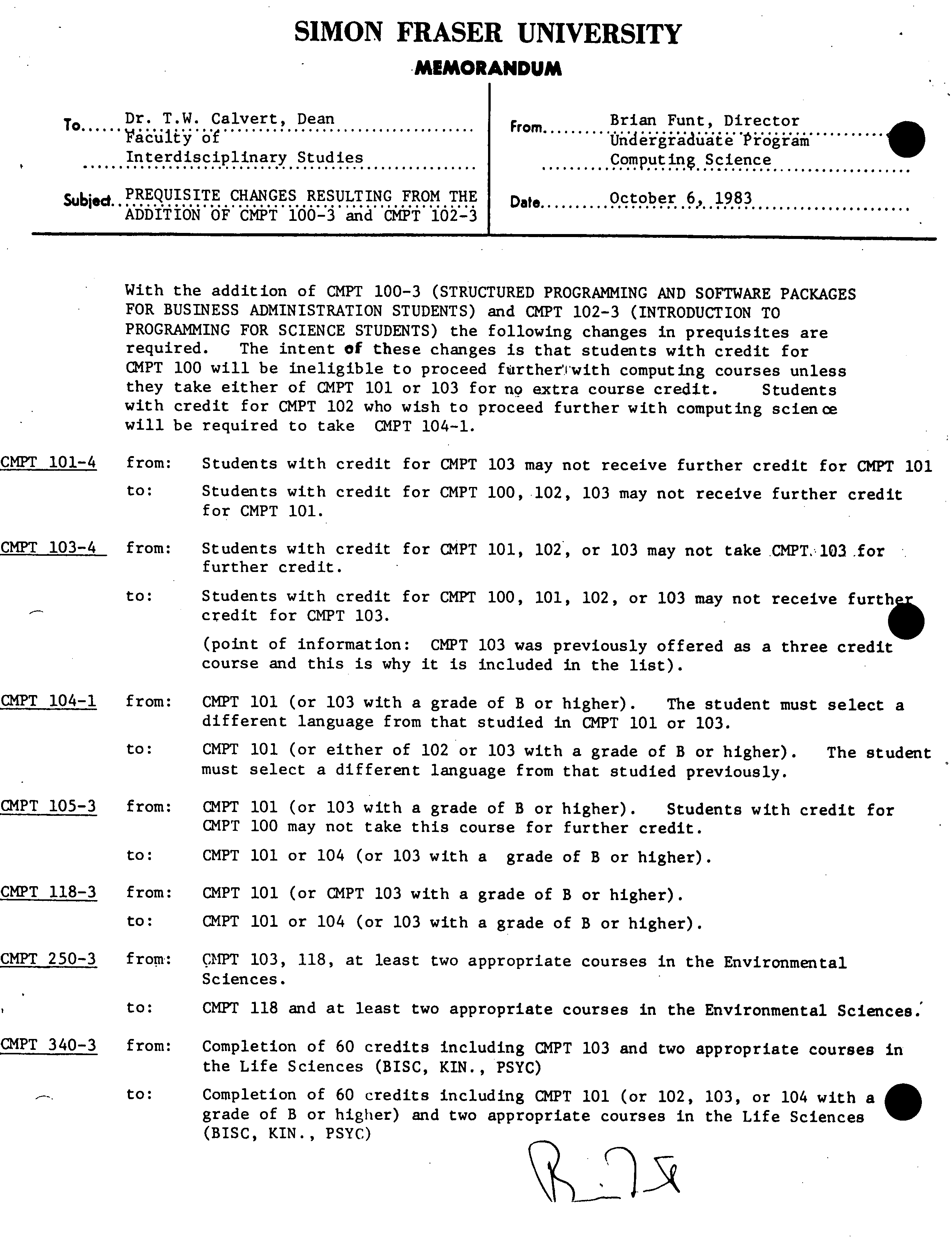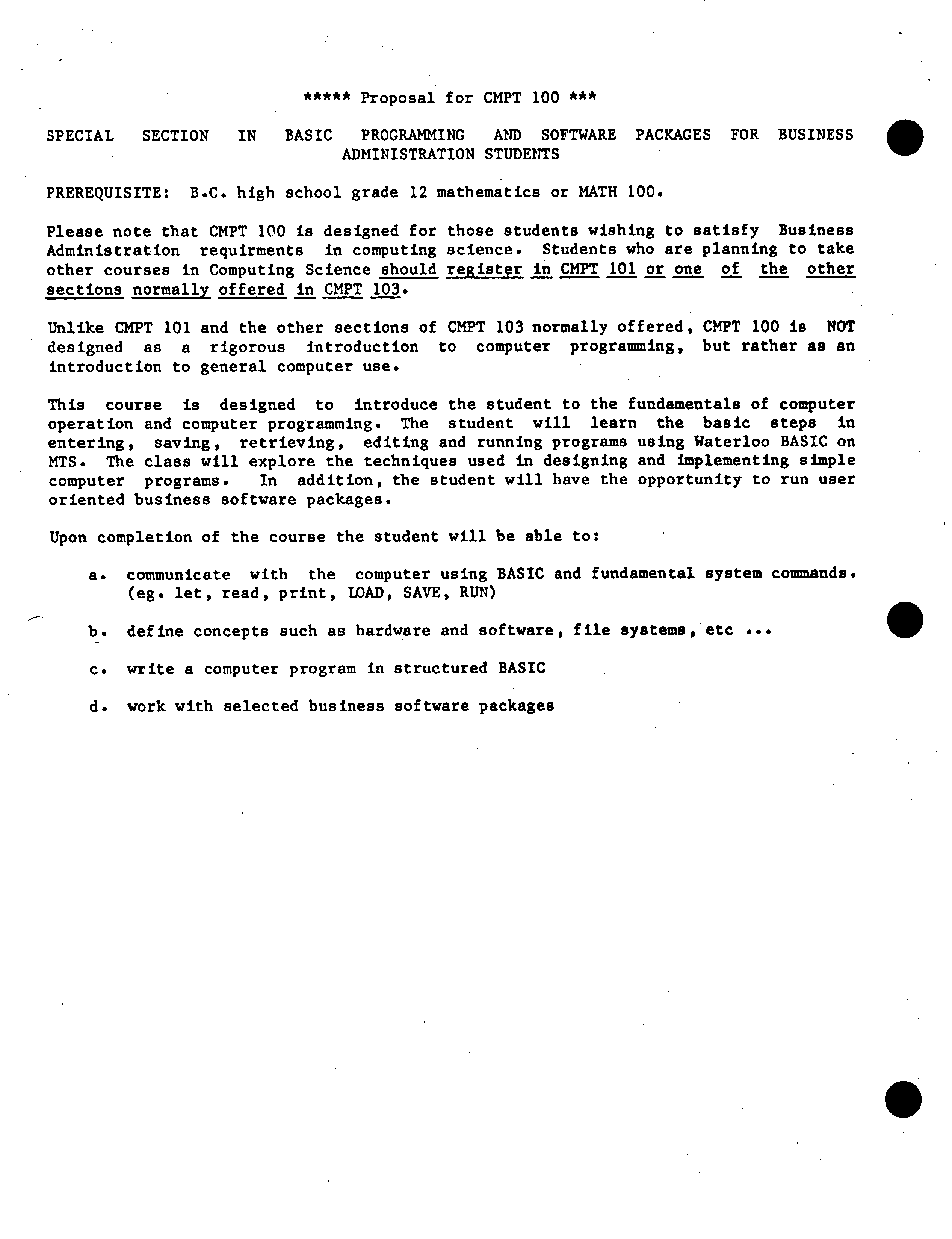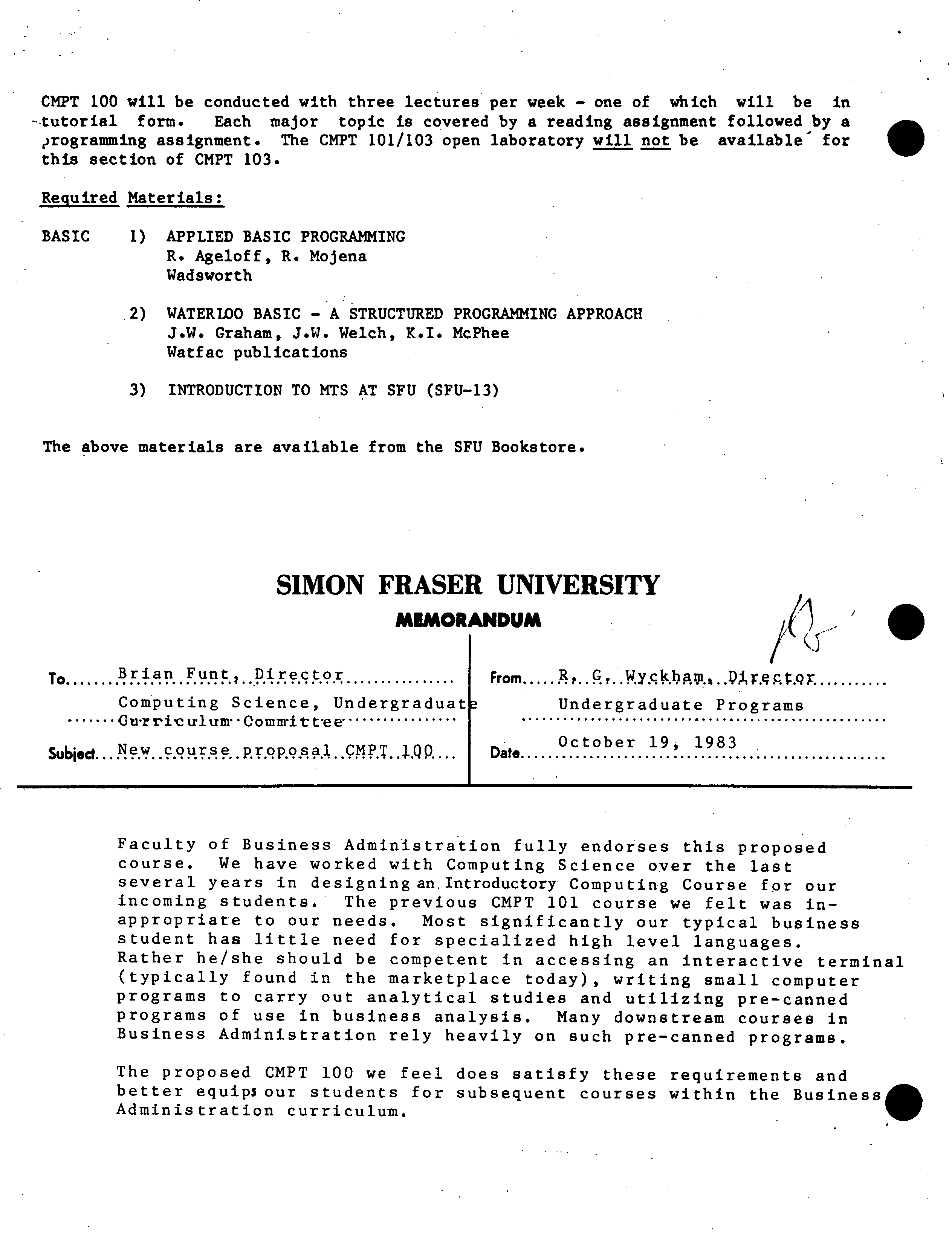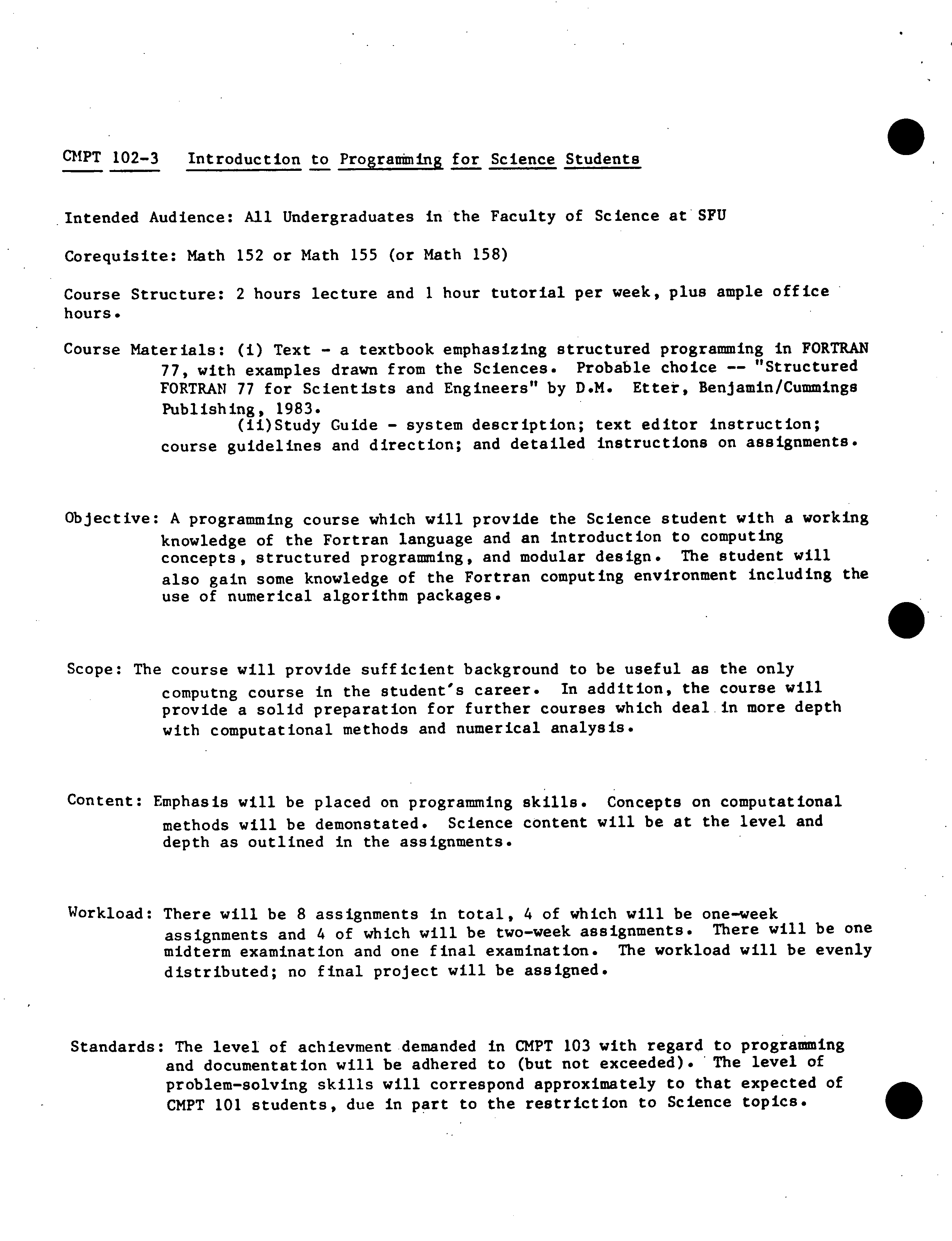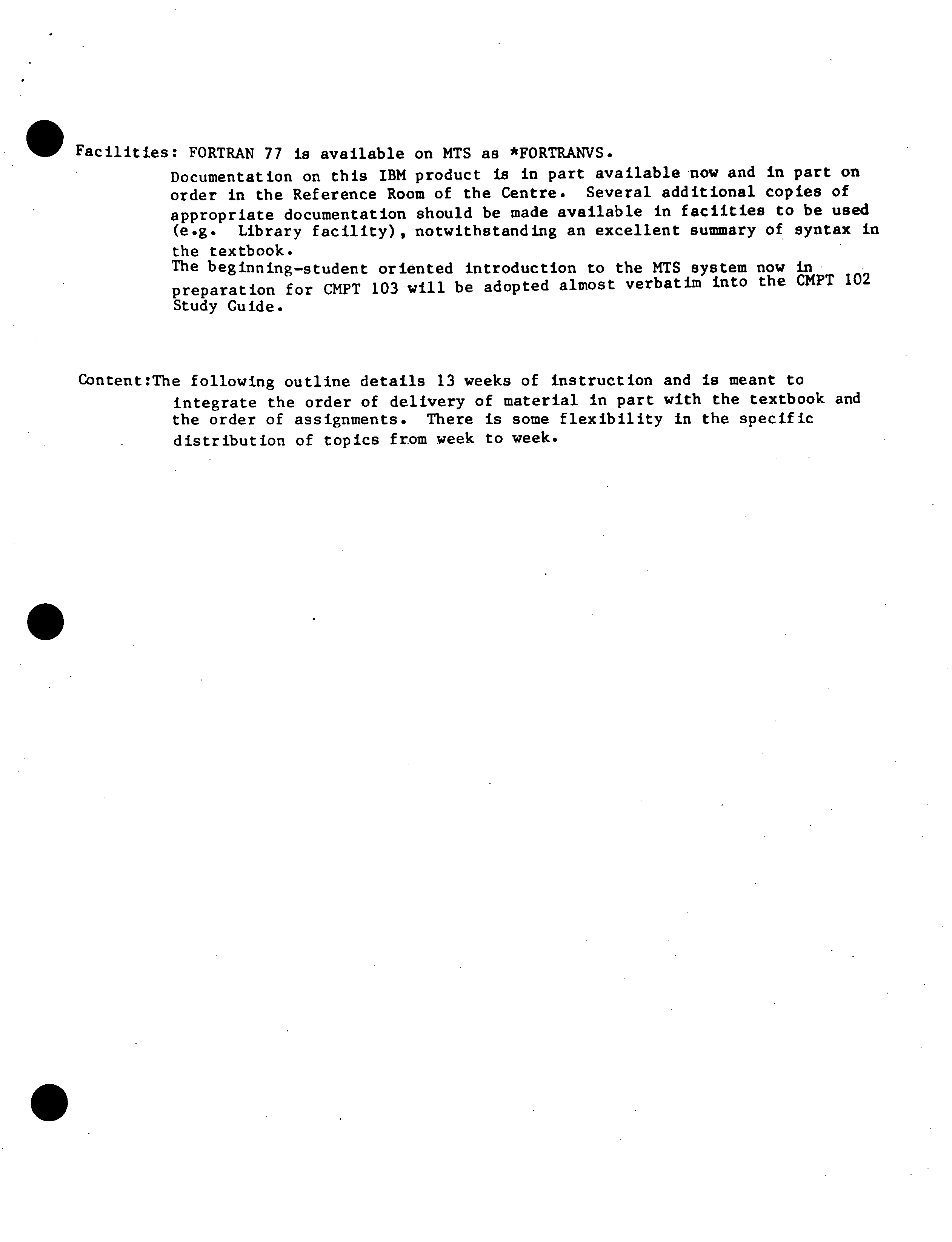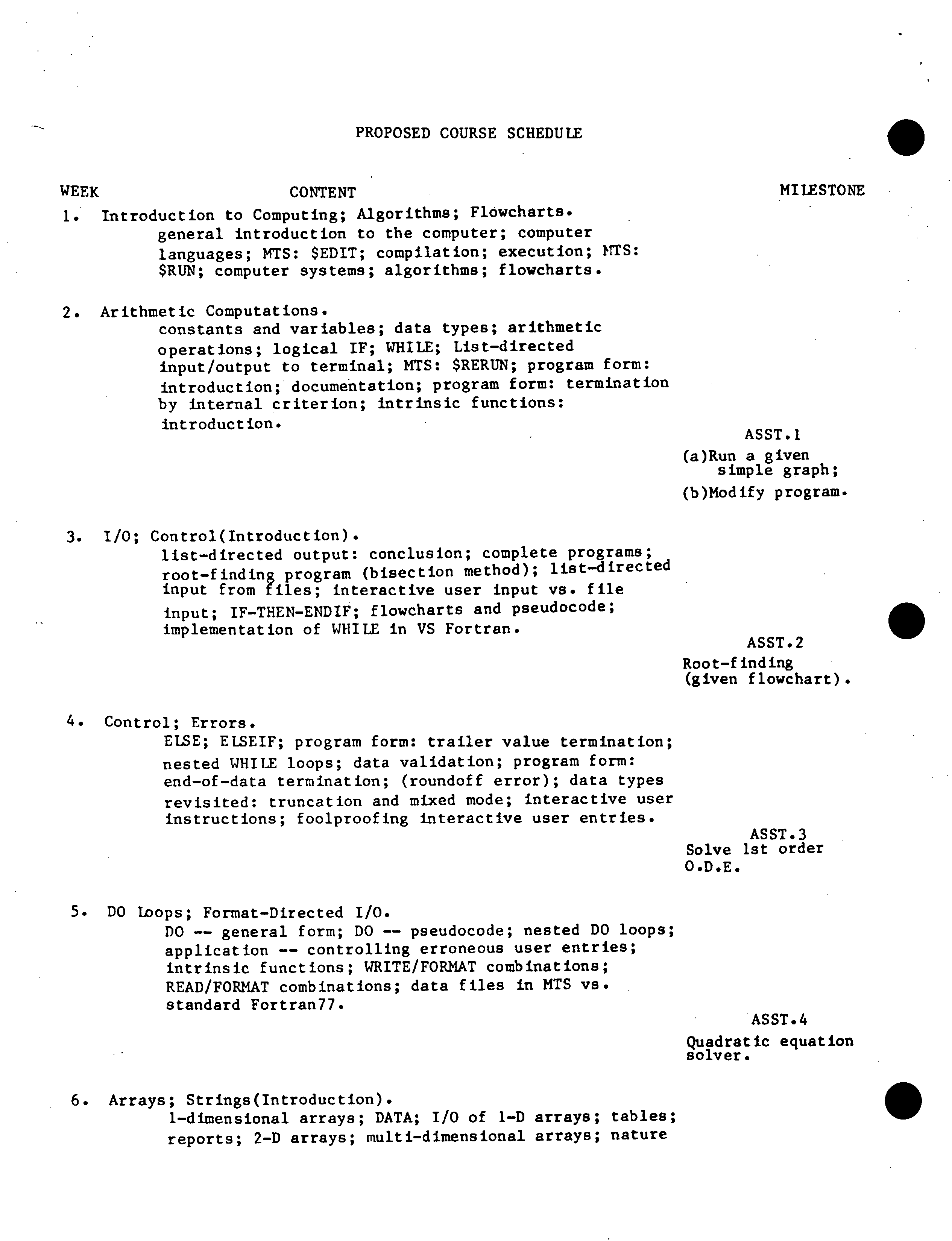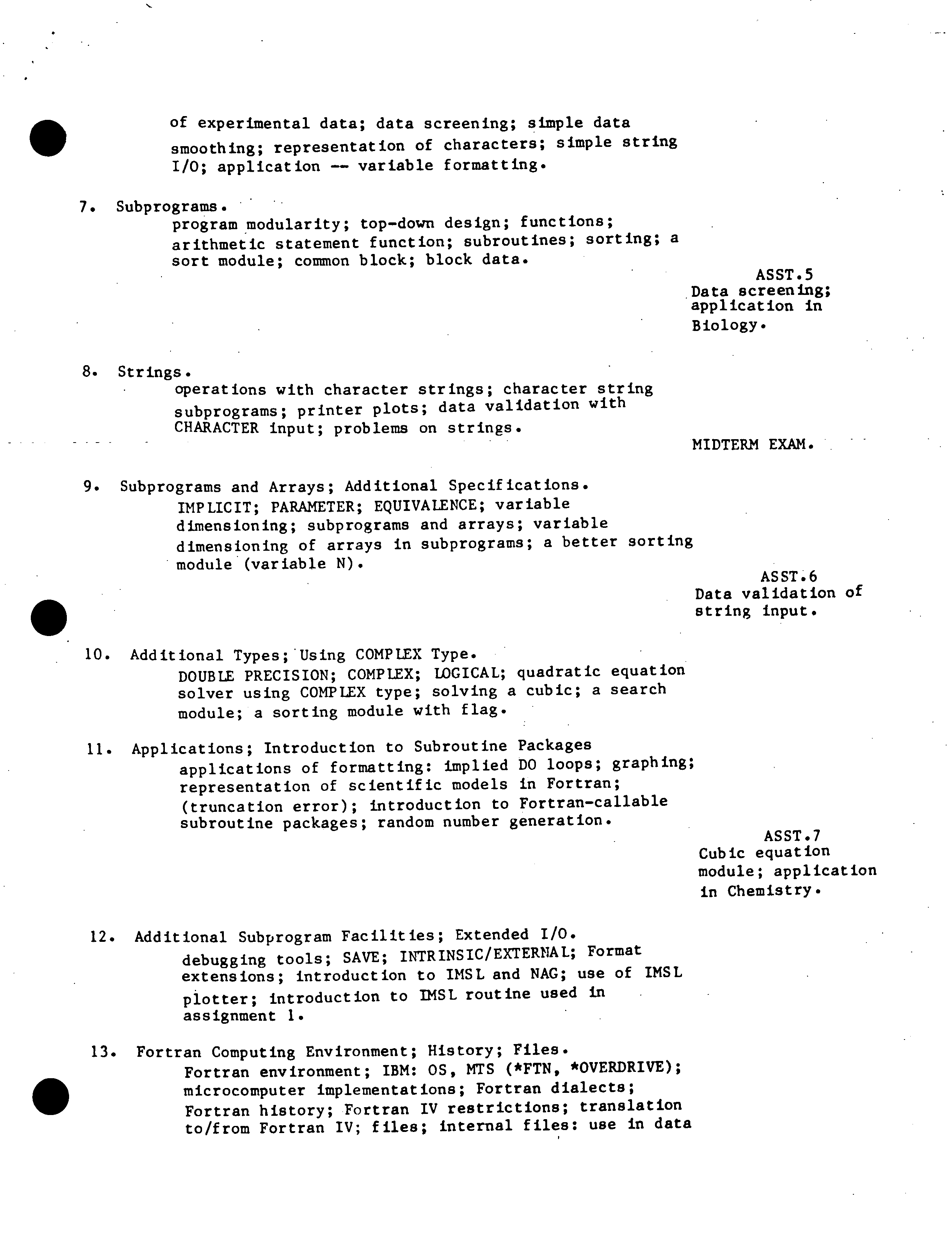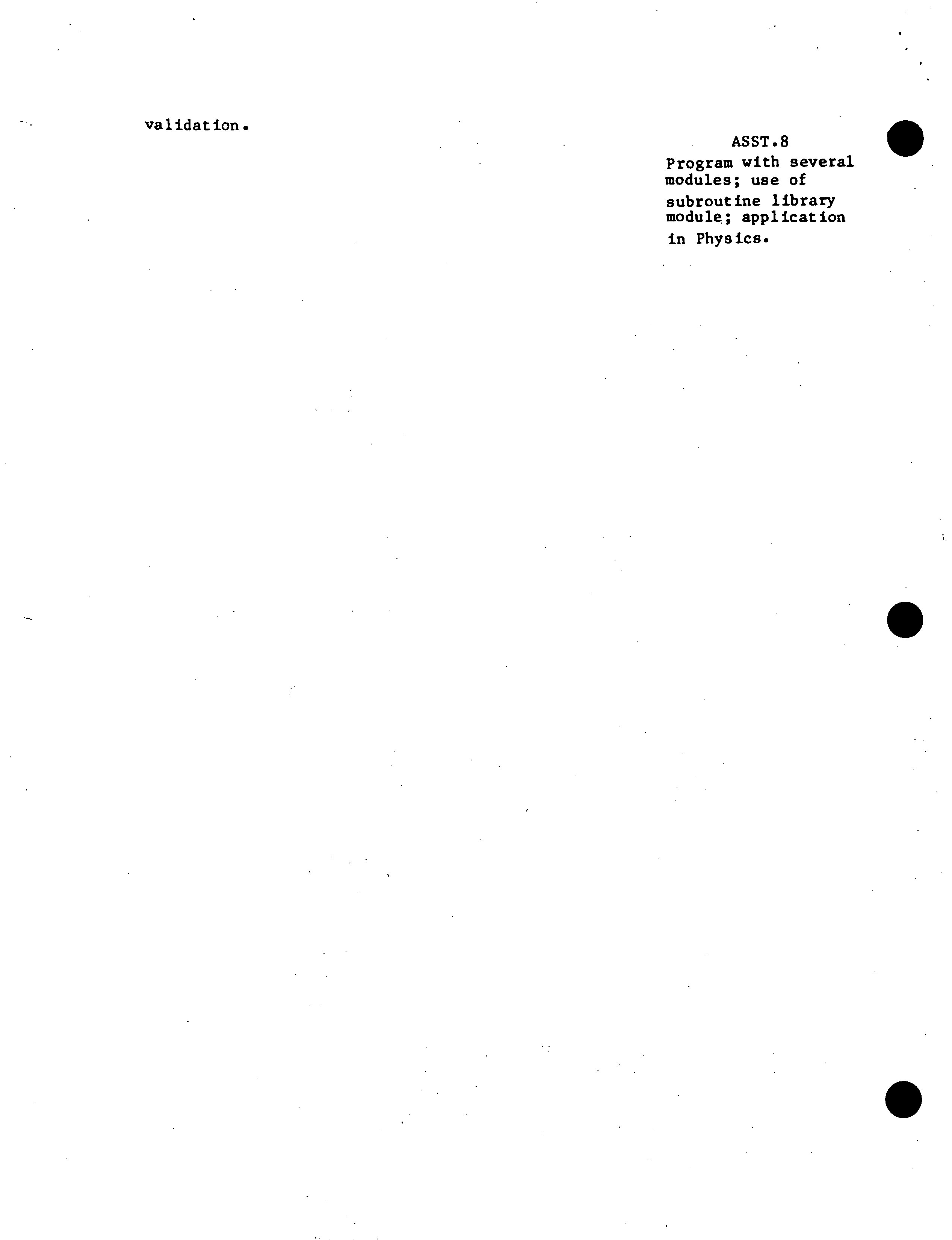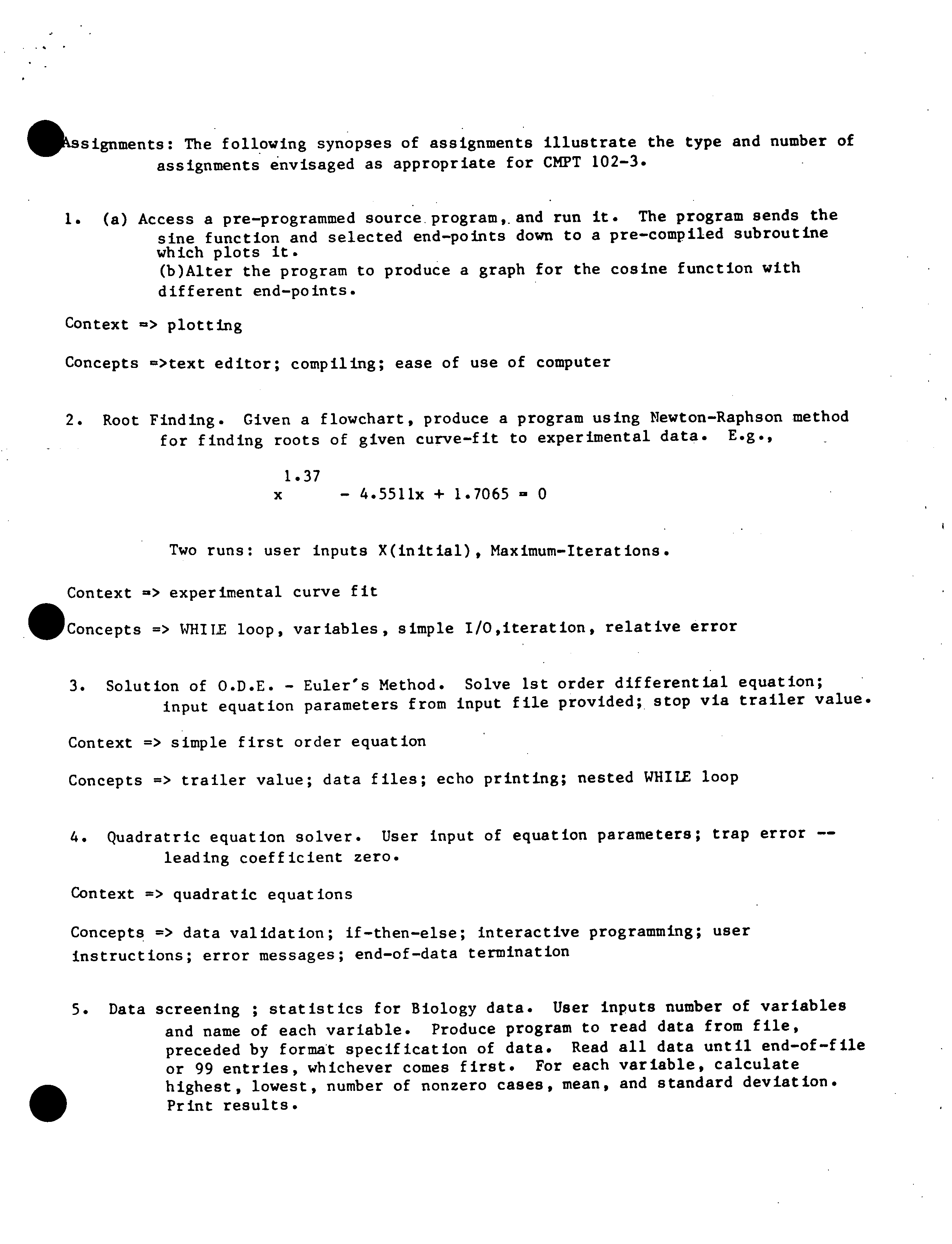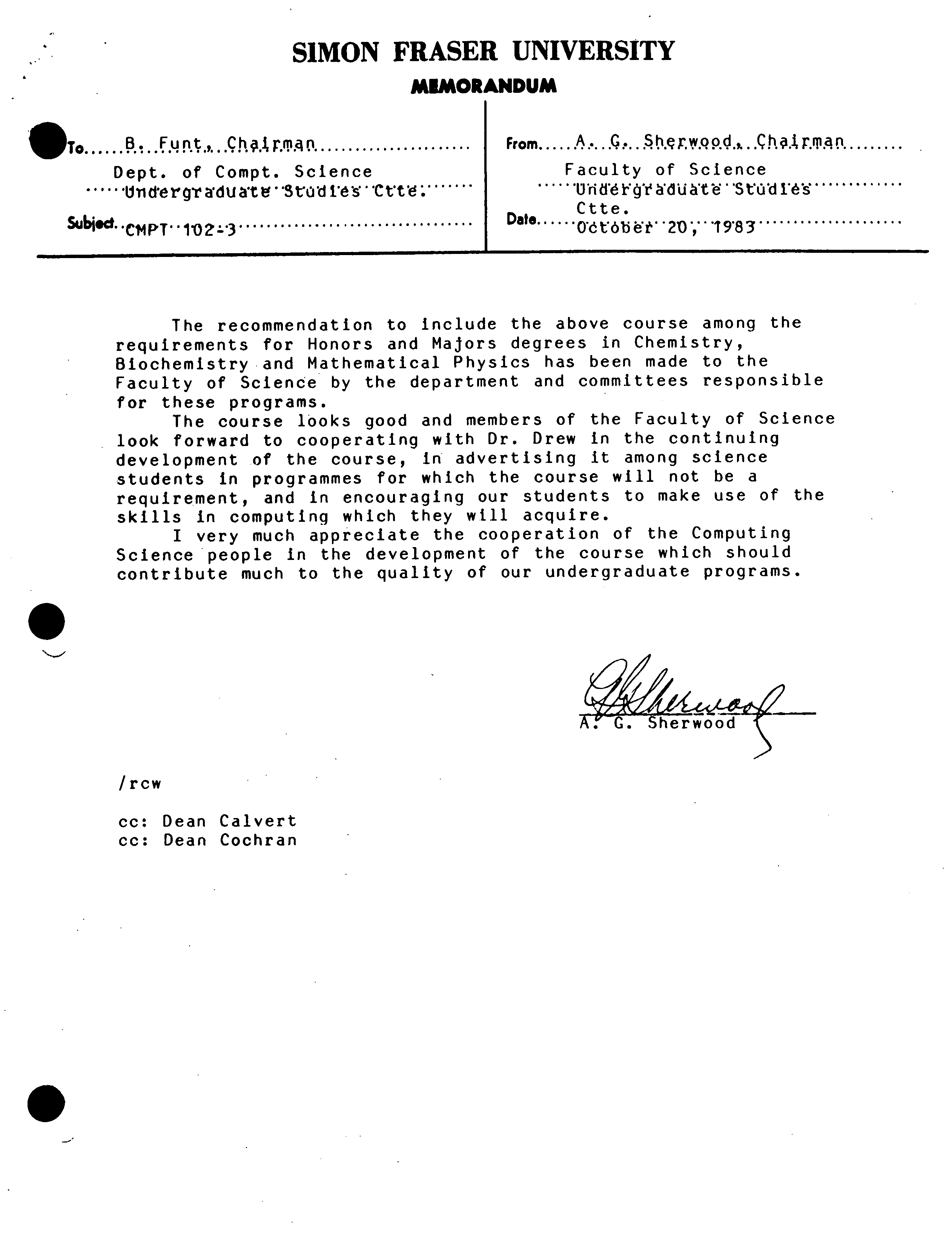SiMON FRASER UNIVERSITY
?
S. T
3-I
MEMORANDUM
•To ............................. ...........................
.
CHANGES - COMPUTING SCIENCE.
From
SENATE COMMITTEE ON UNDERGRADUATE
17 NOVEMBER 1983.
Date
.................................................
Action undertaken by the Senate Committee on Undergraduate Studies
at its meeting of November 15, 1983 gives rise to the following
motion:
MOTION: "That Senate approve and recommend approval to
the Board of Governors, as set forth in S.83-91
the changes in Computing Science, including:-
LL
?
New courses:-
CMPT 100-3 - Structured Basic Programming
and Software Packages for
Business Administration Students
CMPT 102-3 - Introduction to Programming for
Science Students
j i)
?
Prerequisite changes resulting from these
new courses"
Subject to the approval of CMPT 100-3 by Senate and the Board
of Governors the Senate Committee on Undergraduate Studies
approved waiver of the normal two-semester time lag requirement
in order that this course may be first offered in Summer 84-2.
.
SiMON FRASER UNIVERSITY
MEMORANDUM
?
SCuS ?3'Sl
•
Lo ?
. ?
...............r.............
Mr.
H.M. Evans
Registrar and Secretary to the
• .., , .
?
.Vnzgcj.
?
Studies
Subed. 1
•
EW COURSE .
?
................. ?
C4PT 100-3, Structured Basic
From ....... Jan.....
Secretary, Faculty of I.D.S.
e
?
xgcij.
.0
?
c.i,iAwt.......
Committee
Date .......
Qc.tQb.e2.17...1.98.3
.....................
Programming and Software packages
for Business Administration Students.
CMPT 102-3, Introduction to Programming
for Science Students (ISC 83-23 (a)
At a meeting of the Faculty of Interdisciplinary
Studies Undergraduate Curriculum Committee held on
Tuesday, October 11, 1983 members of the Committee
approved the above-noted new courses for inclusion in
the Computing Science Calendar entry.
Would you please place this item on the next agenda
of the Senate Committee on Undergraduate Studies for
consideration.
JB/rj
0
SiMON FRASER UNIVERSITY
MEMORANDUM
To
?
Dr.
èi1t........................................
T.W. Calvert, Dean
Interdisciplinary Studies
Subject
PREQUISITE CHANGES RESULTING FROM THE
ADDITION OF CNPT 100-3 and CMPT 102-3
From ?
Brian Funt, Director
Udgdii ?
Program
ornputin Science ?
.
Date ..........Octobe.....9.
With the addition of CMPT 100-3 (STRUCTURED PROGRAMMING AND SOFTWARE PACKAGES
FOR BUSINESS ADMINISTRATION STUDENTS) and CMPT 102-3 (INTRODUCTION TO
PROGRAMMING FOR SCIENCE STUDENTS) the following changes in prequisites are
required. ?
The intent
of
these changes is that students with credit for
24PT 100 will be ineligible to proceed ftiirtheriwith computing courses unless
they take either of CMPT 101 or 103 for no extra course credit. Students
with credit for CMPT 102 who wish to proceed further with computing science
will be required to take CMPT 104-1.
CMPT
101-4
?
from:
Students with credit for
CMPT
103 may not receive further credit for CMPT 101
to:
Students with credit for
CMPT
100, .102, 103 may not receive
further credit
for
CMPT 101.
CMPT 103-4 ?
from:
Students with credit for
CMPT
101, 102, or 103 may not take
.CMPT.' 103 .for
further credit.
to:
Students with credit for
CMPT
100, 101, 102, or 103 may not
receive furth
-
credit
(point
for
of information:CMPT
103.
?
CMPT
103 was previously offered as
a three credit
6
course and this is why it
is
included in the list).
CMPT 101 (or 103 with a grade of B or higher).
?
The student must select a
different language from that studied in
CMPT 101
or 103.
CMPT 101 (or either of 102 or 103 with a grade of B or higher).
?
The student
must select a different language from that studied previously.
MPT 101 (or 103 with a grade of B or higher).
?
Students with credit for
MPT 100 may not take this course for further credit.
CMPT 101 or 104 (or 103 with a grade of B or higher).
cMPT 101 (or
CMPT
103 with a grade of B or higher).
CMPT 101 or 104 (or 103 with a grade of B or higher).
CNTPT 103, 118, at least two appropriate courses in the Environmental
Sciences.
CMPT 118 and at least two appropriate courses in the Environmental Sciences.
Completion of 60 credits including CMPT 103 and two appropriate courses in
the Life Sciences (BISC, KIN., PSYC)
MPT 104-1 from:
to:
CMPT
105-3
?
from:
to:
CMPT 118-3
?
?
from:
to:
CMPT 250-3 from:
to:
CMPT
340-3
?
from:
to: ?
Completion of 60 credits including
cMPT 101
(or 102, 103, or 104 with a
grade of B or higher) and two appropriate courses in the Life Sciences
(BISC KIN., PSYC)
SENATE COMMITTEE ON UNDERGRADUATE STUDIES
NEW COURSE PROPOSAL FORM
Calendar Information
?
Department: COMPUTING SCIENCE
Abbreviation Code: CMPT Course Number: 100
?
Credit Hours:
3
Vector:
3-1-0
STRUCTURED BASIC PROGRAMMING AND SOFTWARE PACKAGES FOR
Title of Course:
?
BUSINESS ADMINISTRATION STUDENTS
Calendar Description of Course:
This course is designed to introduce the student to the fundamentals of computer
operation and computer programming.
?
The student will learn the basic steps In
entering, saving, retrieving, editing and running programs using WATERLOO BASIC on MTS.
The class will explore the techniques used in designing and implementing simple computer
programs.
?
In addition, the student will have the opportunity to run user-oriented
business software packages.
Nature of Course
?
LECTURE AND TUTORIAL
Prerequisites (or special instructions):
B.C. High School Grade 12 Mathematics, or MATH 100.
Students with credit for CMPT 101, 102 or
103
cannot take CMPT 100 for credit.
What course (courses), if any, is being dropped from the calendar if this course is
approved: ?
NONE
2.
Scheduling
How frequently will the course be offered?
?
EVERY SEMESTER
Semester in which the course will first be offered?
?
84-2
Which of your present faculty would be available to make the proposed offering
possible?
?
S. CAPLIN and G. BIAGIONI
3.
Objectives of the Course
To meet the Faculty of Business Administration's computer programming and
computer literary requirements for their students.
4.
Budgetary and Space Requirements (for information only)
What additional resources will be required in the following areas:
Faculty
?
)
Staff
)
Library ?
) ?
none
Audio Visual
Space
?
)
Equipment
5. Approval
Date: October 5,
1983
Department Chairman
Chairman, SCUS
scus 73-34b: (When completlilg this form, for instructions see Mmorandum SCUS. 7334a.
***** Proposal for CMPT 100 ***
SPECIAL SECTION IN BASIC PROGRAMMING AND SOFTWARE PACKAGES FOR BUSINESS
ADMINISTRATION STUDENTS ?
0
PREREQUISITE: B.C. high school grade 12 mathematics or MATH 100.
Please note that CMPT 100 is designed for those students wishing to satisfy Business
Administration requirments in computing science. Students who are planning to take
other courses in Computing Science should register in CMPT 101 or one of the other
sections normally offered in CMPT 103.
Unlike CMPT 101 and the other sections of CNPT 103 normally offered, CMPT 100 is NOT
designed as a rigorous introduction to computer programming, but rather as an
introduction to general computer use.
This course is designed to introduce the student to the fundamentals of computer
operation and computer programming. The student will learn the basic steps in
entering, saving, retrieving, editing and running programs using Waterloo BASIC on
MTS. The class will explore the techniques used in designing and implementing simple
computer programs. In addition, the student will have the opportunity to run user
oriented business software packages.
Upon completion of the course the student will be able to:
a.
communicate with the computer using BASIC and fundamental system commands.
(eg. let, read, print, LOAD, SAVE, RUN)
b.
define concepts such as hardware and
software, file systems,etc ...
c.
write a computer program in structured BASIC
d.
work with selected business software packages
S
COURSE SCHEDULE
.
MATERIAL
WEEK
TOPIC
COVERED
ASSIGN. ?
TEST
1
Getting Acquainted With
what is a computer, organ-
the Computer
Ization of a computer,
•
computer systems
2
Learning to Communicate
operating systems, assemblers,
1
With the Computer
compilers, interpreters,
•
computer programs
3 Fundamentals of Basic
constants,variables, num-
2
•
bers,characters, keywords,
line numbers, statements
•
4
Unformatted Input/Output
READ .
, DATA, RESTORE, INPUT
3
5
Introduction to Control
GO TO, IF-ENDIF, IF-ELSE
MIDTERM 1
•
Statements
FOR/NEXT
•
6
Additional Control
WHILE-END LOOP, LOOP-END LOOP
Statements
LOOP-UNTIL'
4
7
String Manipulation
subscripts, applications
8
One Dimensional Arrays
defining, subscripts, appli-
5
cations
9
Functions and Subprograms
built-in functions, user def-
MIDTERM 2
•
med functions and subprograms
10
Formatted Input/Output
PRINT USING, INPUT USING,
6
images
11
Data File Handling
reading and writing records
12
Business Application
inventory,
?
interest loans,
7
Programs
•
?
•
•
13 ?
' Review
8
WEIGHT DISTRIBUTION
.Assignments ?
30%
4&4 1 and 2
?
30%
Final exam '
?
40%
CMPT 100
will
be conducted with three lectures
per week -
one of which will be in
--tutorial form. Each major topic is covered by a reading assignment
followed by a
programming assignment. The CMPT 101/103 open laboratory
will not be
available for
this section
of CMPT 103.
Required Materials:
BASIC ?
1) APPLIED BASIC PROGRAMMING
R. Age].off, R. Mojena
Wadsworth
2)
WATERLOO BASIC - A STRUCTURED PROGRAMMING APPROACH
J.W. Graham, J.W. Welch, K.I. McPhee
Watfac publications
3)
INTRODUCTION TO MTS AT SFU (SFU-13)
The above materials are available from the SFU Bookstore.
SiMON FRASER UNIVERSITY
MEMORANDUM ?
I/I)
To........
Brian
?
From
.
.....
Computing Science, Undergraduat
Gurrir1unr Comnrittee
.................
Subject ....
Ne.....q.u•
Undergraduate Programs
983
1
,
October 19
Date
.....................................................
Faculty of Business Administration fully endorses this proposed
course. We have worked with Computing Science over the last
several years in designing an. Introductory Computing Course for our
incoming students. The previous CMPT 101 course we felt was in-
appropriate to our needs. Most significantly our typical business
student has little need for specialized high level languages.
Rather he/she should be competent in accessing an interactive terminal
(typically found in the marketplace today), writing small computer
programs to carry out analytical studies and utilizing pre-canned
programs of use in business analysis. Many downstream courses in
Business Administration rely heavily on such pre-canned programs.
The proposed CMPT 100 we feel does satisfy these requirements and
better equips our students for subsequent courses within the Business
Administration curriculum.
SENATE COMMITTEE ON UNDERGRADUATE STUDIES?
NEW COURSE PROPOSAL FORM
1 'a1endar Information
?
Department: COMPUTING SCIENCE
*Abbreviation Code: CMPT Course Number:
102
?
Credit Hours: 3 Vector: 3-1-0
Title of Course:
?
INTRODUCTION TO PROGRAMMING FOR SCIENCE STUDENTS
Calendar Description of Course:
A
programming course which will provide the Science
student with a working knowledge of the Fortran language and an introduction to
computing concepts, structured programming, and modular design. The student will
also gain some knowledge of the Fortran computing environment including the use
of numerical algorithm packages.
Nature of Course
?
Lecture and Tutorial
Prerequisites (or special instructions):
Corequisite
MATH 152 or MATH 155 (or MATH 158)
Students with credit for CMPT 100 ,lO or 103 c4nflot take CMT 1.02 fox credit.
What course (courses), if any, i being dropped trom the caiendar it this course is
approved:
2. Scheduling
How frequently will the course be offered?
?
Once per year.
Semester in which the course will first be offered?
?
84-3
Which of your present faculty would be available to make the proposed offering
ossible? ?
Dr. M.S. Drew
3.
Objectives of the Course
The course will provide sufficient background to be useful as the only computing
course in the student's career. In addition, the course will provide a solid
preparation for further courses which deal in more depth with computational
methods and numerical analysis.
4.
Budgetary and Space Requirements (for information only)
What additional resources will be required in the following areas:
Faculty
Staff
Library
Audio Visual ?
NONE.
Space
Equipment
5. Approval-
Date: ?
October 6, 1983
?
cc,
•
DepartmerN Chairman
?
Dean ?
Chairman, SCUS
SCUS 73-3/4b: (When compictng this form, for instructions see Memorandum SCUS 73-34a.
CNPT 102-3 Introduction to Progranunlng for Science Students
?
.
Intended Audience: All Undergraduates in the Faculty of Science at SFU
Corequisite: Math 152 or Math 155 (or Math 158)
Course Structure: 2 hours lecture and 1 hour tutorial per week, plus ample office
hours.
Course Materials: (i) Text
77, with examples
FORTRAN 77 for Sc
Publishing, 1983.
(ii)Study
course guidelines
- a textbook emphasizing structured programming in FORTRAN
drawn from the Sciences. Probable choice -- "Structured
Letitists and Engineers" by D.M. Etter, Benjamin/Cummings
Guide - system description; text editor instruction;
and direction; and detailed instructions on assignments.
Objective: A programming course which will provide the Science student with a working
knowledge of the Fortran language and an introduction to computing
concepts, structured programming, and modular design. The student will
also gain some knowledge of the Fortran computing environment including the
use of numerical algorithm packages.
Scope: The course will provide sufficient background to be useful as the only
computng course in the student's career. In addition, the course will
provide a solid preparation for further courses which deal in more depth
with computational methods and numerical analysis.
Content: Emphasis will be placed on programming skills. Concepts on computational
methods will be demonstated. Science content will be at the level and
depth as outlined in the assignments.
Workload:
There will be 8 assignments in total, 4 of which will be one-week
assignments and 4 of which will be two-week assignments. There will be one
midterm examination and one final examination. The workload will be evenly
distributed; no final project will be assigned.
Standards: The level of achievment demanded in CMPT 103 with regard to programming
and documentation will be adhered to (but not exceeded). The level of
problem-solving skills will correspond approximately to that expected of
CMPT 101 students, due in part to the
restriction
to Science topics.
F
acilities: FORTRAN 77 is available on MTS as *FORTJS.
Documentation on this IBM product is in part available now and in part on
order in the Reference Room of the Centre. Several additional copies of
appropriate documentation should be made available in faclities to be used
(e.g. Library facility), notwithstanding an excellent summary of syntax in
the textbook.
The
b
eginning-student oriented introduction to the MTS system now in
preparation for CMPT 103 will be adopted almost verbatim into the CMPT 102
Study Guide.
Content:The following outline details 13 weeks of instruction and is meant to
integrate the order of delivery of material in part with the textbook and
the order of assignments. There is some flexibility in the specific
distribution of topics from week to week.
0
PROPOSED COURSE SCHEDULE
WEEK
?
CONTENT
1.
Introduction to Computing; Algorithms; Flowcharts.
general Introduction to the computer; computer
languages; MTS: $EDIT; compilation; execution; NTS:
$RUN; computer systems; algorithms; flowcharts.
2.
Arithmetic Computations.
constants and variables; data types; arithmetic
operations; logical IF; WHILE; List-directed
input/output to terminal; MTS: $RERUN; program form:
introduction; documentation; program form: termination
by internal criterion; intrinsic functions:
introduction.
3.
I/O; Control(Introductlon).
list-directed output: conclusion; complete programs;
root-finding program (bisection method); list-directed
input from files; interactive user Input vs. file
input; IF-THEN-ENDIF; flowcharts and pseudocode;
implementation of WHILE in VS Fortran.
4.
Control; Errors.
ELSE; ELSEIF; program form: trailer value termination;
nested WHILE loops; data validation; program form:
end-of-data termination; (roundoff error); data types
revisited: truncation and mixed mode; interactive user
instructions; foolproofing interactive user entries.
MILESTONE
ASST. 1
(a)Run a given
simple graph;
(b)Modify program.
ASST.2
Root-finding
(given flowchart).
ASST.3
Solve 1st order
O.D.E.
S
5. DO Loops; Format-Directed I/O.
DO -- general form; DO -- pseudocode; nested DO loops;
application -- controlling erroneous user entries;
intrinsic functions; WRITE/FORMAT combinations;
READ/FORMAT combinations; data files in MTS vs.
standard Fortran77.
ASST-4
Quadratic equation
solver.
S
6. Arrays; Strings(Introduction).
1-dimensional arrays; DATA; I/O of 1-B arrays; tables;
reports; 2-D arrays; multi-dimensional arrays; nature
• ?
of experimental data; data screening; simple data
smoothing; representation of characters; simple string
I/O; application -- variable formatting.
7.
Subprograms.
program modularity; top-down design; functions;
arithmetic statement function; subroutines; sorting; a
sort module; common block; block data.
ASST.5
Data screening;
application in
Biology.
8. Strings.
operations with character strings; character string
subprograms; printer plots; data validation with
CHARACTER input; problems on strings.
-
?
-
?
MIDTERM EXAM.
9.
Subprograms and Arrays; Additional Specifications.
IMPLICIT; PARAMETER; EQUIVALENCE; variable
dimensioning; subprograms and arrays; variable
dimensioning of arrays in subprograms; a better sorting
module (variable N).
?
ASST.6
Data validation of
S
?
string input.
10. Additional Types; Using COMPLEX Type.
DOUBLE PRECISION; COMPLEX; LOGICAL; quadratic equation
solver using COMPLEX type; solving a cubic; a search
module; a sorting module with flag.
11.
Applications; Introduction to Subroutine Packages
applications of formatting: implied DO loops; graphing;
representation of scientific models in Fortran;
(truncation error); introduction to Fortran-callable
subroutine packages; random number generation.
12.
Additional Subprogram Facilities; Extended I/O.
debugging tools; SAVE; INTRINSIC/EXTERNAL; Format
extensions; introduction to IMSL and NAG; use of IMSL
plotter; introduction to IMSL routine used in
assignment 1.
13.
Fortran Computing Environment; History; Files.
is
?
Fortran environment; IBM: OS, MTS (*FTN,
*OVERDRIVE);
microcomputer implementations; Fortran dialects;
Fortran history; Fortran IV
restrictions; translation
to/from Fortran IV; files; internal files: use in data
ASST.7
Cubic equation
module; application
in Chemistry.
validation.
ASST.8
Program with several
modules; use of
subroutine library
module; application
in Physics.
40
•.ssignments: The following synopses of assignments illustrate the type and number of
assignments envisaged as appropriate for CMPT 102-3.
1.
(a) Access a pre-programmed source program,. and run it. The program sends the
sine function and selected end-points down to a pre-compiled subroutine
which plots it.
(b)Alter the program to produce a graph for the cosine function with
different end-points.
Context => plotting
Concepts =>text editor; compiling; ease of use of computer
2.
Root Finding. Given a flowchart, produce a program using Newton-Raphson method
for finding roots of given curve-fit to experimental data. E.g.,
1.37
x ?
- 4.5511x + 1.7065
?
0
Two runs: user inputs X(initial), Maximum-Iterations.
Context > experimental curve fit
Concepts => WHILE loop, variables, simple I/0,iteration, relative error
3.
Solution of O.D.E. - Euler's Method. Solve 1st order differential equation;
input equation parameters from input file provided; stop via trailer value.
Context => simple first order equation
Concepts => trailer value; data files; echo printing; nested WHILE loop
4.
Quadratric equation solver. User input of equation parameters; trap error --
leading coefficient zero.
Context => quadratic equations
Concepts => data validation; if-then-else; interactive programming; user
instructions; error messages; end-of-data termination
5.
Data screening ; statistics for Biology data. User inputs number of variables
and name of each variable. Produce program to read data from file,
preceded by format specification of data. Read all data until end-of-file
or 99 entries, whichever comes first. For each variable, calculate
• ?
highest, lowest, number of nonzero cases, mean, and standard deviation.
Print results.
Context •> experimental data
Concepts -> arrays; logical operators; variable formatting; data validation; data
counting; character data
?
0
6.
Data validation of numeric data read in as character strings. Produce program to
analyze input for non-numeric data. Flag Individual erroneous characters
with asterisks on a second line of output.
Context => data validation of input file
Concepts => character string manipulation; error flagging using graphic-type
formatting
7.
Module: Cubic equation solution. Produce subroutine to solve a general cubic,
covering all three possiblities of root types. Explanation (simple) In
Study Guide of how the van der Waals equation of state for a real gas can
be written as a cubic. Write program which calls module.
Context > Chemistry
Concepts => flexible subprograms; use of mathematical routines in practical
applications.
8. Numerical algorithm package; several modules. Write program to calculate
two-dimensional profile of vibrating string using method outlined in Study
Guide. Call sophisticated plotting routine for presentation of results in
graphic form.
Context => Physics
Concepts => debugging modular programs; scientific programming; interchangable
modules; top-down design; Fortran-callable numerical subroutine packages.
SiMON FRASER UNIVERSITY
?
MEMORANDUM
*To
......
B.n•h]•rp•n
.......................
Dept.
of
Compt. Science
UdergTduat S dre^
ct•t0
SUbd CIIPT .
1O2.3..................................
From..........
PRAP
Faculty of Science
nfë
tL
ädUät Stud
.............
Date
Ctte.
Date...... .tôiet
.
20," T983.....................
The recommendation to include the above course among the
requirements for Honors and Majors degrees in Chemistry,
Biochemistry and Mathematical Physics has been made to the
Faculty of Science by the department and committees responsible
for these programs.
The course looks good and members of the Faculty of Science
look forward to cooperating with Dr. Drew in the continuing
development of the course, in advertising It among science
students in programmes for which the course will not be a
requirement, and in encouraging our students to make use of the
skills In computing which they will acquire.
I very much appreciate the cooperation of the Computing
Science people in the development of the course which should
contribute much to the quality of our undergraduate programs.
S
A.
C. Sherwood
/rcw
cc: Dean Calvert
cc: Dean Cochran
.,



